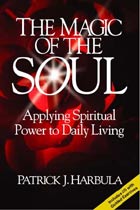A Five Step Method
By DR. PATRICK J. HARBULA
Among the teachings regarding meditation, there are a myriad of different techniques and approaches to what is considered a fundamental universal goal. This goal could be defined in many different ways, but most would agree that it is concerned with the expansion of consciousness, to become more aware of what we really are.
Often the path of meditation involves moving from one method to another until we find the teaching with which we resonate. No technique or teaching is ever wrong or right or the best, it is merely a rung on the ladder which spirals ever higher along the evolutionary cycle.
I present here methods that have been especially effective in my meditative experience. They combine many of the basic techniques from both the East and the West. Through these methods, the flavors of different schools may be experienced, possibly offering insight into a style with which a meditator may feel comfortable. They may also be utilized as a specific meditative form, providing a well-rounded diet, so to speak, of techniques, both new and old, designed to take one further along the journey towards self-realization and mastery. The practice of any single stage set forth would be beneficial, but these five steps used synergistically create a very balanced and complete process for transformation.
One may begin any meditation by aligning the physical, emotional and mental energies with the vibration of the soul or higher self.
CONCENTRATION
Concentration, the first stage, is the act of focusing the attention. This step could include visualization exercises, such as mentally holding the image of a geometrical symbol: a circle, a circle with a dot at its center, an equal-armed cross, a triangle, five-pointed star or the six-pointed Star of David. A physical object or picture can also be a valuable tool for these exercises. Some recommend the selection of a card from the Tarot as a focus of study for a designated period of time: five minutes per day, every day for a week. Another simple yet powerful method is to focus and hold briefly the attention at the ajna center, the point just above and between the eyebrows. A person engaged in the resolution of a mathematical problem does this naturally.
Conscious projection of thought energy is another possibility for this stage. This is done by focusing one’s thought power on a situation or thing with a specific purpose in mind. For example, one might consciously project thoughts of peace and harmony for world healing. Concentrated thought is similar to the intensity of the laser beam, whereas the unfocused mind is likened to diffused light. This can also be used as a healing technique for oneself or others. One method is to focus one’s attention on the soul purpose of an individual and project love energy to support the working out of that purpose in the life.
There are many techniques for disciplining the mind. Readers are encouraged to develop their own, through experimentation and study.
TRANSCENDENCE
Having achieved facility with the stage of concentration, one is ready for transcendence. The goal of this stage is to go beyond the limits of the objective plane, to still the mind. Some students have difficulty with this stage due to the restless nature of the mind. A simple technique to aid in calming the mind is the sounding of a chant either audibly or inaudibly. The sacred OM sounded repeatedly with the emphasis on the vibration of the inner or outer sound is another suggestion. Or one may wish to watch the breath as it is drawn in and out rhythmically, and to sense one’s consciousness becoming lighter and lighter until it is lighter than the air being breathed.
Another form, associated with the Zen tradition, teaches us to include, rather than block, sounds, thoughts or sights (if the eyes are open). The goal is actually to become aware of the complete sensory and intuitional experience. This awareness automatically guides one beyond the known realms of the physical, emotional and mental vibration and will tend to merge one’s awareness with the vibration of the One.
The transcendental phase can raise one’s consciousness to what some Eastern schools call the buddhic plane, the place of archetypal seeds and symbols beyond the mental – the plane of total unity.
CONTEMPLATION
In this stage the meditator can use a seed thought or an archetypal symbol as a focal point to create a new pattern in daily life. The state of mind facilitated by the transcendent stage allows for a receptivity toward new insights not always realized at the moment of the experience. It may take days or weeks, months, even years to integrate the full impact from the gifts received.
The goal in this stage is to relate insights or visions to everyday experiences, to formulate plans and procedures for implementing the intuited information. In this way the meditator is utilizing both hemispheres of the brain.
It is generally recommend that a seed thought or symbol be used for a certain period of time (a month or a zodiacal period) in order to create a cyclic rhythm.
One recommended cyclic procedure is to use a seed thought from one new moon to the next, utilizing the time from new to full moon as the inbreathing, receptive phase of the cycle. The time from the waning to the new moon is then used as a time for the out breathing, assertive action phase. The point of the full moon is considered the greatest opportunity for revelation.
It is also valuable to record the results from the contemplation stage in a daily journal. This facilitates the grounding of the meditative experience.
ILLUMINATION
Illumination is the next stage and includes the process of embodiment. Here is where the energies and insights are brought directly into the personality vehicle, illuminating the mental, emotional and physical bodies. One way to achieve this stage is through visualization. One might visualize becoming wholey filled with what the West calls “the Christ Light” and the East, “Universal Buddhi.” These terms represent the highest energy of unconditional love.
Affirmation may also be used as a tool for illumination. The affirmation could relate to information received and processed in the contemplation stage, or the phrase forming a seed thought can become an affirmation. When this is the case, and the seed thought (or affirmation) is held in the mind periodically throughout the day, the illumination process enters one’s daily life. It has been said that meditation is not just a 15-to-30 minute process, but a 24-hour commitment. If one perseveres, the vibrational level achieved in the morning meditation ultimately becomes a way of life.
INSPIRATION
At this stage the meditator may consciously connect, or identify, with a source of inspiration. This could be one’s own higher self, the Spiritual Hierarchy, an inner master, teacher, saint or sage with whom one identifies, or the Universal Presence known as God.
Occasionally the meditator has a tendency to separate the inner life from the outer life. However, the inspiration stage is most effective when including the impetus needed to reflect the inner experience into outward activities.
Ideas received will be in the form most beneficial at the meditator’s point of necessity: a message of encouragement or enlightenment, or simply the required energy to implement the soul purpose in current activities. The objective of this stage is to bring a sense of positive action into the day to create fulfillment of one’s highest goals and inspire the best in all whom the meditator contacts.
The meditation may be closed with a prayer, affirmation or the sounding of the OM three times. The Great Invocation is a highly recommended nondenominational prayer for invoking spiritual forces and establishing the energies of the Aquarian Age.
For more articles from the Meditation Magazine Archives, please visit this link:
http://livingpurposeinstitute.com/articles-2/meditation-articles/
For information on Living Purpose Institute: life coaching, life coach training and certification, workshops, classes, meditation ceremonies, ceremonial sweat lodge ceremonies, retreats, videos, and much more, please visit:
http://livingpurposeinstitute.com/
For a complimentary life coaching session.
Call: 805-469-9847
Living Purpose Institute
2593 Young Avenue Thousand Oaks, CA 91360




